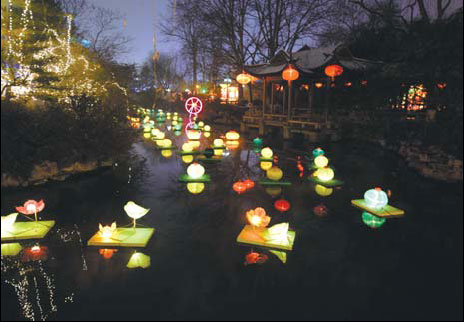Lantern Festival losing its luster
 0 Comment(s)
0 Comment(s) Print
Print E-mail China Daily, February 22, 2013
E-mail China Daily, February 22, 2013
|
|
|
Lotus lanterns bob in the water at Baotu Spring Park. Ju Chuanjiang / China Daily |
The Lantern Festival marks the end of the two-week Lunar New Year celebration. Lighting lanterns is a tradition dating back to the Eastern Han Dynasty (AD 25-220), and this year the festival falls on Feb 24.
Legend has it that a human accidentally killed a holy bird of the Emperor of the Heaven. The emperor was furious and ordered his general to burn everyone to death as punishment.
But before the general could take any action, one of the emperor's kind-hearted daughters informed the people of her father's will.
An intelligent old man suggested that every family light lanterns to fool the general. His suggestion worked.
When the general was about to set fire to the people, he saw that the land was engulfed by an ocean of lights and fires. He then reported to the emperor that his mission was accomplished. All lives were spared.
I have seen many beautiful lanterns but the most memorable one is the one I made in elementary school.
It was a homework project, which I almost forgot to do until the last minute. I made it in a hurry out of iron wire and white paper. I drew the Monkey King, a popular figure in the ancient classic Journey to the West, on the simple cube lantern lighted by a candle.
Unfortunately, my first lantern was short-lived - it was burned to a crisp before the end of the day.
My hometown of Jinan, Shandong province, used to have many lantern factories that displayed their best creations every Lantern Festival.
Made of steel, iron, bamboo, silk and glass, and lighted with colorful electronic bulbs, the lanterns varied in size - from a three-story building to a match box. The lanterns could be divided into two categories - traditional and modern designs.
The traditional ones were usually designed in the shape of Chinese zodiac signs or inspired by traditional folk tales and legends. The most common ones were the red globe-shaped lanterns, representing wealth and good luck.
The modern ones were designed in the shape of airplanes, satellites and rockets to showcase the country's progress.
The factories have all folded. But this classification prevails even in today's lantern shows hosted by parks.
In Jinan, the annual lantern show in Baotu Spring Park was first held in 1980 and has become the city's most renowned showcase of lanterns. Starting from Chinese New Year, this year's show runs until March 3.
Expecting to awaken my childhood memory of lanterns, I went to the show before sunset one day in the Spring Festival, so that I would have enough time to see the lanterns both in daylight and at night.
With 2013 being the Year of the Snake, the reptile is one of the most popular icons. A big yellow snake-shaped lantern, about 5 meters tall and 3 meters wide, greeted me at the south gate of the park. But frankly speaking, I was disappointed - it was too crude and looked more like a chicken than a snake.
The next large mechanical lantern at the south gate highlights the theme of the park. Three blue water sprays measuring 3 meters in diameter and 2 meters high represent the famed Baotu Spring of the park, which boasts about 30 springs.
But I noticed that the technology of making lanterns in Jinan has not progressed with the times. There are lanterns in the shape of rockets, planes, giant pandas, dragons and those inspired by stories to teach people to be generous, modest and credible, but they did not adopt the latest technology.
This year's show hosts 40 large lanterns and 20,000 lights. I do not find the artistic detailed hand-drawn small lanterns, which were common in lantern shows during my childhood. Most lanterns are industrial products and large in size. The brows, mouths, noses and eyes are mostly made by adhesive tapes. Some faces do not even have details like a nose or mouth. They only look good at night.
I am always eager to see lanterns floating on spring waters. One clever invention is lotus flower lanterns floating on water. Even during the day, the brightly colored lanterns add vibrancy to the still spring waters.
As night falls, the water becomes invisible, except for reflections of the lanterns, and the lotus lanterns move slowly against the backdrop of darkness with occasional lights reflected from the water surface, creating a fairyland fantasy for visitors.
The Baotu Spring, in the southwestern part of the park, is made up of three springs, 1 meter apart from each other. Water spurts out in three water columns in the center of a 2-meter-deep and 20-by-20-meter pool. The springs gush to the height of about half a meter above the jade-green water surface and roar like muffled thunder.
Before leaving by the north gate, I passed by a group of cartoon-image lanterns that are targeted at children. But most children did not seem too keen on them.
With other entertainment avenues, the lantern show has gradually lost its shine and now exists purely as a tradition.







Go to Forum >>0 Comment(s)